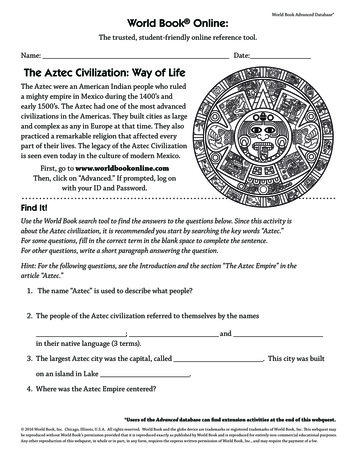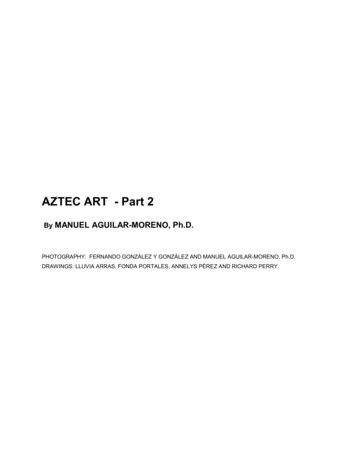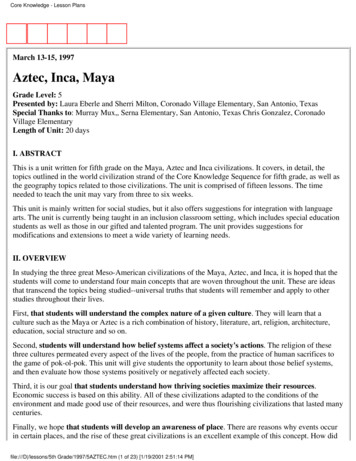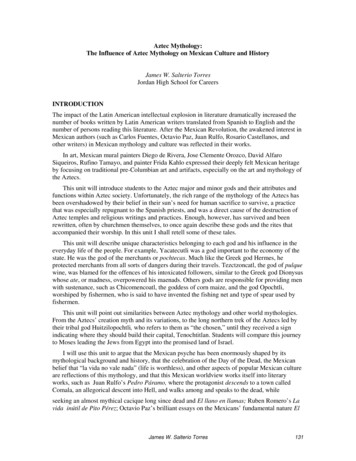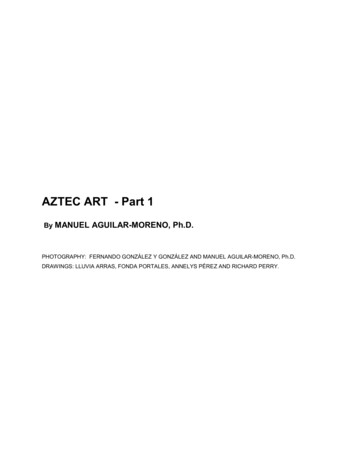
Transcription
AZTEC ART - Part 1By MANUEL AGUILAR-MORENO, Ph.D.PHOTOGRAPHY: FERNANDO GONZÁLEZ Y GONZÁLEZ AND MANUEL AGUILAR-MORENO, Ph.D.DRAWINGS: LLUVIA ARRAS, FONDA PORTALES, ANNELYS PÉREZ AND RICHARD PERRY.
TABLE OF CONTENTSINTRODUCTIONTHE AZTEC ARTISTS AND CRAFTSMENToltecaMONUMENTAL STONE edication StoneStone of the WarriorsBench ReliefTeocalli of the Sacred War (Temple Stone)The Sun StoneThe Stones of Tizoc and Motecuhzoma IPortrait of Motecuhzoma IISpiral Snail Shell (Caracol)Tlaltecuhtli (Earth God)Tlaltecuhtli del Metro (Earth God)CoatlicueCoatlicue of olxauhqui ReliefHead of CoyolxauhquiXochipilli (God of Flowers)Feathered SerpentXiuhcoatl (Fire Serpent Head)The Early Chacmool in the Tlaloc ShrineTlaloc-Chacmool
ChicomecoatlHuehueteotlCihuateotl (Deified Woman)Altar of the Planet VenusAltar of Itzpaopalotl (Obsidian Butterfly)Ahuitzotl BoxTepetlacalli (Stone Box) with Figure Drawing Blood and ZacatapayolliStone Box of Motecuhzoma IIHead of an Eagle WarriorJaguar WarriorAtlantean WarriorsFeathered CoyoteThe Acolman Cross (Colonial Period, 1550)TERRACOTTA SCULPTUREEagle WarriorMictlantecuhtliXipec TotecCERAMICSVessel with a Mask of TlalocFunerary Urn with Image of God TezcatlipocaFlutesWOOD ARTHuehuetl (Vertical Drum) of MalinalcoTeponaztli (Horizontal Drum) of FelineTeponaztli (Horizontal Drum) With Effigy of a WarriorTlalocFEATHER WORKThe Headdress of Motecuhzoma IIFeathered FanAhuitzotl ShieldChalice Cover
Christ the SaviorLAPIDARY ARTSTurquoise MaskDouble-Headed Serpent PectoralSacrificial KnifeKnife with an Image of a FaceGOLD WORKFIGURESBIBLIOGRAPHYINTRODUCTIONA main function of Aztec Art was to express religious and mythical concepts tolegitimize the power of the State. This artistic language spoke predominantly throughthe form of iconographic symbols and metaphors. For example, the image of the eaglesymbolized the warrior and the sun at its zenith. Images of serpents were linked to thegods Tlaloc and Huitzilopochtli, and thus were represented as water or fire serpents,respectively. Representations of frogs as aquatic beings were also reminiscent ofTlaloc.The conch shell was related to fertility, life, and creation. As indicated byHeyden and Villaseñor (1994), sculpture served as communication through visualmetaphors, which were realized with a purity of techniques that allowed for refinementof detail.It is unwise and misleading for modern Western scholars to label most forms of Aztecexpression as fine art. Vaillant (1938) mentions that the Aztecs, like many ancientnonwestern civilizations, did not have a word to describe fine art, and that they did notargue over questions of aesthetics; nor did they create objects to be observed for theirown sake. Instead they created objects intended to serve a well-defined function--toindoctrinate standard religious, political, and military imperatives. Understanding theartistic principles of the ancient indigenous past is difficult given our own cultural biases
and our own definitions of an artistic world. But it is easy to recognize that the Mexicaappreciated beauty in terms of their own culturally dictated standards.THE AZTEC ARTISTS AND CRAFTSMENThough historians and European chroniclers found reasons to document informationdescribing the daily life of Emperors, members of the imperial family, and warriors, thereis little information about the day-to-day life of Aztec artisans and craftsmen despite thefact that artists at Tenochtitlan and other Aztec cities constituted a numerous class withits own quarters and organizations; they preserved the class below that of the pochteca(long-distance merchants), though they were in some respects affiliated to the upperclasses. Not so much is known about the guilds of the quarrymen, who are sometimesmentioned in ethnohistorical sources without much detail. The only groups of artists thatwere much taken into account were those associated with the decorative arts: thegoldsmiths, the jewelers, and the amanteca (feather-workers). They used various toolsof stone, copper and wood, and wet sand for the abrasion of jade and crystal. Soustelle(1979) states that gold (teocuitlatl), silver, amber, crystal, pearls, and amethysts werepopular materials for creating rich jewels, and vibrantly dyed feathers decorated fineclothing. Most importantly, they had an infinite amount of patience to any unique cannondictated by their rulers and religious leaders.According to Soustelle (1979), these people were named tolteca (the Toltecs) becausethe origins of their art-work were traditionally associated to the ancient Tolteccivilization, whom the Aztecs venerated as their forefathers over the centuries.ToltecaInitially, the Aztecs were a nomadic tribe with no craftsmen or artists that arrived to theValley of Mexico in the year 1325, overpowering the citizens of small settlements, suchas Colhuacan or Xochimilco, which preserved the ancient art traditions of Tula (theToltec capital) after its fall, along with its language and customs. According to Sahagún(1951-1969, Book 3), the Toltecs, meaning literally a group of skilled craftsmen, were all
very skilled artisans. To be referred to as a tolteca, or Toltec, was an honor for Aztecartisans; it served as a reminder that as craftsmen they were members of the artistictraditions of a golden era. Aztec craftsmen were inspired by their Toltec ancestors, whocreated magnificent feather mosaics, worked gold and other precious metals, andcarved stone to create monumental sculptures for their kings and godsAs Aztec rulers expanded the political boundaries under their control, reaching even theremote tropical regions, wealth began to accumulate rapidly and artisans grew in socialstatus as they became more in demand. The tolteca class provided artisans and theirfamilies with certain privileges that common people did not possess. However, mostartisans did not rise from their own stations to any positions of considerable power, andso they maintained peaceful relationships with the ruling class. Presumably artists,given their unique talents, preferred to stay in their positions where they were respectedand admired for their abilities.Artisans who worked directly for the Aztec ruler performed their jobs either inside thepalace and or in their own homes, where raw materials such as stones, feathers, orprecious metals could be sent. But they did not work alone. Interestingly, the artist’sworkshop witnessed the entire family's participation. Each family member worked inprescribed roles to complete pieces. For example, the wife of an artist wove blanketswith the rabbit hair, dyed feathers, and embroidered clothing, depending on theprofession of her husband. Children in such households would learn and inherit theartistic traditions of their parents.Accounts regarding an artist's salary are rare. One account reveals that artisans werewell paid for their work. The stone sculpture of Motecuhzoma II was executed byfourteen sculptors who were paid with clothing for their wives and themselves, cotton,ten loads of calabashes, and maize given as an advance.After the work wascompleted, they were each given two servants, cocoa, crockery, salt, and more clothing.Although artists may have been given good compensation, they were also taxed;however, they were not required to give personal service or any agricultural labor. And iflegal disputes arose, the tolteca class had chiefs who represented them before the
authority of the law.MONUMENTAL STONE SCULPTUREAztec sculpture was not the result of random inspiration but a monumental synthesis ofreligious and cultural concepts. An important characteristic of Aztec sculpture is theabstraction of whole images that retain realistic, concrete details.Sculpturesrepresented their myths, dreams, and illusions of life and death [Fig. 1]. Monumentalitywas another important trend in Aztec sculpting. However, monumental art was not justthe representation of something massive and enormous; it was the visual symbol offorce of an idea, simply executed and manifested in the relationship betweendimensions. Aztec monumentality awed and frightened the spectator and imposed amanipulated impression of power that the State invested in all Aztec art.Ocelotl-CuauhxicalliA vessel in the form of a jaguar, the Ocelotl-Cuauhxicalli was used to store the hearts ofsacrificed victims [Fig. 2].On the inside bottom of the cuauhxicalli (vessel of theeagles), two figures with striped bodies and skeletal jaws are piercing their ears withsharp bones. The rim of the vessel is composed of concentric circles conveying jadeswith eagle feathers. In a general sense, this colossal ocelotl-cuauhxicalli is a monumentdedicated to the underworld, the earth, and the deified kings of the past.According to Pasztory (1983), the great power of the jaguar is shown in this vesselwithout its grace and swiftness, a somber version of an otherwise vivacious animal. Asa vessel related to the act of sacrifice and death, the jaguar represents the god of theearth, where the corpse would be buried, and the underworld, where the soul of thedead would travel. The image of the ocelotl, or jaguar, stands for the earth receivingsacrificial offerings. Jaguars were also icons of royalty and status symbols. Rulers worejaguar skins and were associated with the feline. Artists might have witnessed thejaguar first hand in the zoos of Motecuhzoma II and other Aztec kings.The two skeletal figures inside the vessel probably indicate the importance of ancestry
the Mexica people. They are shown with the smoking mirror foot of Tezcatlipoca, god ofthe many forms and protector of warriors, who possibly represents dead kings of pastcivilizations disguised as deities. They also extract blood from their ears utilizing bloodletting implements similar to the ones used in the penitential rituals performed by theancient Aztec kings, another sign that they are symbols of ancestry. As Esther Pasztorypoints out, ultimately, the vessel, commissioned by Motecuhzoma II, links his own reignwith the gods of the past.Cuauhtli-CuauhxicalliThe Cuauhtli-Cuauhxicalli, like the Ocelotl- Cuauhxicalli, was sculpted in the form of ananimal--the eagle. The circular hole in the back of the figure indicates that this sculpturewas a cuauhxicalli, or sacrificial vessel. According to Matos and Solís (2002), theCuauhtli-Cuauhxicalli stored the hearts and blood of the sacrificed victims so that thedeities, descending from the heavens, could feed themselves on the offerings [Fig. 3].In ancient Mexico, the cuauhtli (eagle) symbolized both the sun and a strong warriorwho fought the powers of the night under the direction of his patron deity Huitzilopochtli,the god of war. The eagle was an important symbol in ancient times since it wasresponsible for feeding the sun with the hearts and blood of the sacrificed victims, whichgave the sun its energy to make its daily journey across the sky. This vessel points to avital belief encompassed in the Aztec worldview--that life and death are joined. Deathmust occur so that life can exist, making human sacrifice a necessary component inensuring the survival of both the sun and the universe, and consequently, human life.This offering vessel is a magnificent example of the fine artistry of the Aztec sculptor.Sculpted as if the artist wanted to imitate in stone the real bird, the eagle eye issurrounded by delicate feathers while the tail is made of longer feathers that fallvertically. The details of the vessel are rich in texture and form.Dedication StoneThis skillfully carved greenstone plaque was made in commemoration of the completionof the Temple of Huitzilopochtli at Tenochitlan in the year 8 Reed or 1487 [Fig. 4].Where this panel was located originally is still unknown, but relief panels with dates,such as this one, were usually set into architecture like stairways and pyramid
platforms. Very similar stones have been found in the Great Temple of Tenochitlan andthis plaque was probably a part of those.In the lower half of the stone, the glyph 8 Reed is carved in an abstract design withdouble outlines. The upper half of the stone is similar to the carvings in the Bench Reliefand the Stone of Tizoc. In the plaque, the rulers Ahuitzotl and Tizoc are dressed up aspriests holding incense bags and piercing their ears with a bone. Tizoc was in powerbetween 1481 and 1486, and his brother Ahuitzotl succeeded him and ruled from 1486to 1502. Blood is flowing from their heads into an incense burner and is represented asa serpent into the maw of the earth monster border. Between the two Emperors, there isa grass ball of sacrifice, or zacatapayolli, with the bone piercers or maguey thorns usedfor auto-sacrifice (blood-letting) stuck in it. Also, streams of blood are flowing from thewounds in each of their legs. Both kings are identified by their own glyphs: Tizoc by his“bleeding leg” glyph and Ahuitzotl by the water being with a curly tail. The two kingsappear in profile, with their heads and legs pointing sideways, while their torsos appearin a full frontal view. They are barefoot, which is a symbol of divinity. Above the twomen, the date 7 Reed appears, whose meaning is unclear.This stone depicts an act of devotion. According to Matos and Solís (2002), the Aztecsbelieved that humans could achieve immortality by their good actions, such as devotionacts performed for the gods. Expanding the Great Temple of Tenochitlan, dedicated tothe patron Mexica gods Huitzilopochtli and Tlaloc, was the duty of every ruler or tlatoani.This plaque reveals the same sentiment. Tizoc began expanding the Great Temple andhis brother Ahuitzotl finished the completion of the project. Also, both emperors areperforming an act of sacrifice, which involves the offering of maguey thorns or bonepiercers covered with their own blood and inserted in a zacatapayolli to mother Earth.Stone of the WarriorsDiscovered in 1897 near the main square in Mexico City, the Stone of the Warriors isfull of reliefs of warriors in procession holding their weapons [Fig. 5]. As described byPasztory (1983), the soldiers approach a symbol of sacrifice fully armed for battle, eachwearing a different headdress; they approach the grass ball, or zacatapayolli. It is
possible that a ruler at one time stood next to the grass ball, but time has abraded thestone making it unclear. These 14 carved warriors might represent the City ofTenochitlan and even the Aztec Empire’s mighty power and strength.On top of the sculpture, the earth monster image (either Tlaltecuhtli or Itzpapalotl) iscarved, symbolizing the devourer of human blood and hearts. The earth covers thephysical bodies of the dead and feeds on them, and it requires the sacred liquid of bloodto be in balance with the universe.The Stone of the Warriors probably served at one time as an altar or a throne owing tothe fact that the depression in the center was made during the colonial period.Bench ReliefUntil an early Chacmool sculpture was found, the Bench Relief was thought to be one ofthe earliest Aztecs sculptures ever found [Fig. 6].According to Pasztory (1983), the Bench Relief is composed of 52 panels that weretaken away and re-used to reconstruct buildings in Tenochitlan. There is the importantemblem depicted in the central stones of the monument, which shows the grass ball ofsacrifice (zacatapayolli) stuck with thorns and human bones used to draw blood. Twowarriors surround the sacrificial grass ball of thorns. These warriors belong to a highrank in Aztec society suggested by their clothing, such as their three types ofheaddresses, one with the turquoise diadem of a chief, a headdress of feathersassociated with a lord, and a two feather headdress, which indicate a high position. Thewarriors are also carrying such weapons as spear throwers (atlatl), spears, and shields.All the images represent humans, except for the one on the left, who has a leg ending ina representation of smoke rather than a human leg. According to Pasztory (1983), thefigure with the smoke leg is mixing human and divine features. The person with divinefeatures is disguised as the god Tezcatlipoca, with the smoking mirror on his hair andhe is leading the other Aztec noble-warriors to battle. The nose bar, as well as histurquoise diadem headdress, is symbols of royalty.The figure on the left mightrepresent a king of Tenochitlan, possibly Motecuhzoma I who is praying, as suggested
by the curled flower design in front of his face. If this is so, then the monument’s daterange between 1440 and 1469.There are only a few traces of the stucco paint used to decorate the Bench Relief. TheAztecs might have made an imitation, in this relief, of a Toltec bench relief, since it isclosely similar to Toltec prototypes. The Tula bench relief in the Burnt Palace alsodepicts a procession of warriors with feathered serpent borders. An Aztec trend in thisrelief is the grass ball of sacrifice in the center, serving as a penitential symbol and anemphasis on the image of the Aztec ruler.Teocalli of the Sacred War (Temple Stone)The Temple Stone, named the teocalli (temple) of the Sacred War by Alfonso Caso, is acommemoration to the New Fire Ceremony of 1507, the sacred war, and the imperialpower of the Mexica [Fig. 7].The Temple Stone is composed of sixteen images and six glyphs on both of its sides,taking the shape of an Aztec temple. A scene of a natural world with an eagle and acactus on the back of the sculpture alludes to the founding of Tenochtitlan [Fig. 8].According to the migration legend, the patron god Huitzilopochtli told them to build asettlement in the place where they would see an eagle landing on a cactus growing on alake [Fig.9]. When the Mexica saw the vision, they founded Tenochtitlan on LakeTetzcoco.On top of this colossal monument there is the date 2 House (1325), indicating that thiswas the date of the traditional founding of the Aztec capital. The entire monumentsymbolizes the Aztec capital Tenochtitlan, rising from Lake Tetzcoco. The monumentitself is mixing the elements of a royal throne, a temple, and a year bundle. For theAztecs, a main temple of a city represented the city’s symbol and in manuscripts, aburning temple represents that the city has been conquered. In Mesoamerica, templeswere shaped in the form of pyramids symbolizing the mountains, where fertility andcreation happens, where the wombs of creation are kept, which are the cavesthemselves. The word city in Nahuatl is altepetl, which means “water-mountain.”
Some scholars suggest that the Temple Stone was in fact a royal throne oficonographical meaning. This monument was found in Moctezuma II’s palace in 1831and might have served as his symbolic or actual throne. The sculpture also is related toyear bundles representing the 52 years of an Aztec century. The year 2 Reed (glyph ofthe New Fire Ceremony), 1 Flint knife, and 1 Death are represented in the stonesculpture. According to Pasztory (1983), during important feasts, the year bundles wereused as seats for the nobility, thus making the Temple Stone a royal throne, a symbol ofthe Aztec capital Tenochtitlan as a mountain pyramid, and the 52 years cycle. At the topof the stone there is a sun disk showing the glyph 4 Movement. The disk is flanked by agod, or a priest dressed as the god Huitzilopochtli in the left, and by Moctezuma II onthe right [Fig.7]. The sun disk symbolizes the Aztec dedication to a solar cult and a newera of their rule.Both god and human king carry sacrificial knives and bones fordrawing blood. A grass ball of sacrifice full of thorns to draw blood, appear on top of thesolar disk. In a sense, the Temple Stone is itself being crowned by an Aztec Emperorand a patron deity, who are drawing sacrificial blood as a solar symbol for light, life, andtime.Opposing this image of life is the representation of death below the sun disk on top ofthe seat. Below the sun disk, lies the Earth Monster (Tlaltecuhtli) with a skull beltsymbolizing the voracious power of the earth.Furthermore, the Earth Monster isflanked in the sides by weaponry, such as shields, spears, and war banners, all of themrepresenting emblems of war. The cuauhxicalli vessels, which are being represented forthe first time in a royal monument, are adorned with eagle feathers and jaguar spots,thus making them symbols to the Aztec warrior orders of the eagle and the jaguar. So,the sculpture is a monument to the sacred war in which the Mexica are conquering theEarth.On both sides of the stone sculpture, is a pair of seated images with skeletal jawswearing triangular loincloths and feather headdresses, typical of Aztec warrior regalia[Fig. 10]. They might represent the ancestors of the Aztecs, the ancient rulers prior tothe Mexica conquest, or the Aztec deities, since the image on the left has thatmoustache and those goggles attributed to the rain god Tlaloc. Another figure has a
royal diadem, and he is either a ruler or the fire god Xiuhtecuhtli. The Aztecs associatedTlaloc and Xiuhtecuhtli to older civilizations, especially with the Toltecs; they believedthat Tlaloc was the patron god of the Toltecs. The Aztecs understood the importance ofhonoring their ancestors and sought to find their spiritual support for the Empire.According to Pasztory (1983), when someone, such as Moctezuma II, sat in this royalthrone, in a symbolical way he might have been resting on top of the earth, theunderworld, and on his back, he carried the sun and the ancient past of the ancestors.Also, the glyph representing the 1 Flint knife, next to Huitzilopochtli, is the mythical datein which the Aztecs began their migration from Aztlan. Motecuhzoma II is glorifying hisheritage and his ancestors by wearing a headdress of plumes tied to sticks. This wasthe headdress wore by the nomadic Chichimec ancestors of the Mexica. The TempleStone embodies the concept of unbreakable continuity of Aztec and Toltec dominations,and the right of the Aztecs to supersede the Toltec civilization by conquest, sacrificialdeath, and by the divine guidance of Huitzilopochtli.The Sun StoneCarved in the late Post-Classic period, 1479, the year 13 acatl, during the reign of thesixth emperor Axayacatl, this very elaborate monument to the sun in its manymanifestations is also known as the Calendar Stone and as the Aztec Calendar, thoughin reality it was never used as a calendar [Fig. 11]. The stone also represents humansacrifice related to the cult of Tonatiuh, god of the sun.At the center of the Sun Stone, the wrinkled face of a blond-haired Tonatiuh is depictedwith his tongue ravenously hanging from his mouth in the shape of an obsidiansacrificial knife. (Some scholars think that the deity is actually Tlaltecuhtli, the night sunof the underworld). His wrinkles indicate his old age, and his blond hair associates himwith the golden sun. But it is his tongue that links him so graphically to human sacrifice,so hungry is it for human blood [Fig. 12].Tonatiuh is surrounded by the symbol Nahui Ollin, the date on which the current sun ofmotion (the Fifth Sun) was created in Teotihuacan. In the four flanges of the Ollin signappear the names of the four previous creations, which are Four Jaguar, Four Wind,
Four Rain, and Four Water. Adjacent to the flanges, the four directions or cardinalpoints of the Universe are represented like a cosmological map.The North is awarrior’s headdress, which symbolizes the military power of the Mexica and theirgrowing Empire. The South is a monkey and represents a part of one of the previoussuns or ages in the myth of creation.The East is an obsidian dagger or tecpatlrepresenting human sacrifice. The West is the Tlalocan, the house of the rain-godTlaloc, and symbolizes water, essential for human survival.In the next outer circle are shown the 20 days of the month. The Solar Calendar wascomposed of 18 periods of 20 days plus five days called nemontemi (useless andnameless). Starting from the position of the symbol of the North and heading clockwise,the Nahuatl names of the months correspond to the figure carved in each box that formsthe circle. In order, they are: Cipactli (Crocodile), Ehecatl (Wind), Calli (House),Cuetzpallin (Lizard), Coatl (Serpent), Miquiztli (Death), Mazatl (Deer), Tochtli (Rabbit),Atl (Water), Itzcuitli (Dog), Ozomatli (Monkey), Malinalli (Plant, Grass), Acatl (Reed),Ocelotl (Jaguar), Cuauhtli (Eagle), Cozcacuauhtli (Vulture), Ollin (Movement), Tecpatl(Flint or Obsidian), Quiahuitl (Rain), and Xochitl (Flower). Out of this circle, eightarrowheads symbolizing the sun’s rays scattering throughout the Universe point in alldirections.The outermost circle depicts the bodies of two fire serpents that encompass the SunStone [Fig. 11]. These serpents symbolize the connection between the upper and lowerworlds, and work like an axis mundi (axis) uniting the two opposite worlds. Their openedmouths at the bottom represent the underworld. Two heads emerge from their openedmouths: Quetzalcoatl, personified as Tonatiuh (the sun) on the right, and Tezcatlipoca,personified as Xiuhtecuhtli (god of the night) on the left. These two gods have theirtongues out touching each other representing the continuity of time. This interactionsymbolizes the everyday struggle of the gods for supremacy on Earth and in theHeavens. In other words, the tongues touching each other signify the rising and settingof the sun, which are always in contact.The Sun Stone symbolizes the destruction of the Fifth Sun, and acts as a celebration forthe creation of the world where the forces of creation and destruction play equal roles.
The iconography also suggests that the Sun Stone is a testament to Aztec victory. Theglyph above the I Flint knife states the day on which the Aztecs began their migrationfrom their original homeland of Aztlan. According to Pasztory (1983), this date washistorically important; in that year, 1428, the Aztecs defeated the Tepanecs and becamethe new rulers of the Valley of Mexico. In that context, the Sun Stone supports thebelief that the reign of the Aztec Empire was to be a new era in Mesoamerica.The Stones of Tizoc and Motecuhzoma IThe Stone of Tizoc depicts the victories of Tizoc, the Emperor during1481-86, and is amasterpiece of intricate stone carving [Fig. 13]. Pasztory (1983), states that themonumental Stone of Tizoc is the first of its kind that was dated and associated to aknown king.In 1988, a similar stone dedicated to the King Motcuhezoma I wasdiscovered [Fig. 14]. These stones, called temalacatl, were very probably used forgladiatory sacrifices of important captured warriors. The cavities that they each have inthe middle of a solar disc suggest that they were also used as cuauhxicallis, vesselswhere the hearts of the sacrificed victims were deposited.In the Stone of Tizoc, the King, portrayed here in the guise of the god Tezcatlipoca, andhis conquests are glorified in stone. He is identified by his glyph, the symbol for leg. Atthe top of the cylinder is a sun disk with eight rays. Next to the cylinder, a sky borderdecorates the upper part and a register conveying the maw of the earth monsterborders the bottom. The frieze between the two borders portrays fifteen Aztec warriorsholding captive victims by the hair. Each of the fifteen conquering warriors wears asmoking mirror in his headdress, the symbol of Tezcatlipoca, the god of shape shiftingand protector of warriors. Tizoc is the only warrior wearing the hummingbird helmet ofthe god Huitzilopochtli.Only one of the fifteen warriors is identified as Tizoc; the rest might have been captainsunder his rule [Fig. 15]. Pasztory (1983) states that the Aztecs had fifteen lords, orfifteen city districts, referred to as the calpulli, and the number fifteen possibly
symbolizes the Mexica’s political and military divisions led by Tizoc.The captivesrepresent their rulers since they combine human and divine attributes by dressing astheir city’s principal deities. Two female figures present are associated with the femalepatron deities of Culhuacan and Xochimilco. It was a tradition of the Aztecs to takesome of the local idols of a conquered city and bring them to a special temple inTenochtitlan. The stone suggests that these events take place in the human realm andthe divine realm, in which historical Emperors conquer specific towns while the deitiesensure success or failure.According to Pasztory (1983), some of the conquests that appear on the sculpture areattributed not to Tizoc, but to his forefathers. The glyphs associated with the capturedtowns suggest that they stand for major Aztec conquests up to the time of Tizoc, or theymight belong to some ethnic groups rather than cities. The Codex Mendoza attributes14 conquests to Tizoc, but the monument probably commemorates the conquests of theAztec expansion embodied by Emperor Tizoc.The Stone of Tizoc was inspired by Mixtec-Puebla manuscript painting evidenced by thesimilarity of the sun disk border and the earth monster border to images in MixtecPuebla documents. Also, each of the captives is identified by their own glyphs, whichindicates that they are identified in the tradition of the Mixtec-Puebla historical codices.The stone also shows that the Aztecs were deliberately imitating Toltec models bymaking their own imperial art. Reference to Toltec models is limited only to clothingdetails of the warriors, who wear the butterfly chest ornament like those worn by theAtlantes of Tula [Fig. 16]. However, the use of a historical image in a cosmic setting todecorate a ritual object is especially Aztec in origin, and the patron gods of the Aztecsare more emphasized in the stone.The stone as a whole represents the Aztec empire, originated by conquest, and thecommemoration of Tizoc’s reign. It is interesting to notice that the glyph next to Tizoc’sprisoner is that of his first campaign, Matlatlan.Ironically, Tizo
AZTEC ART - Part 1 By MANUEL AGUILAR-MORENO, Ph.D. PHOTOGRAPHY: FERNANDO GONZÁLEZ Y GONZÁLEZ AND MANUEL AGUILAR-MORENO, Ph.D. . the god of war. The eagle was an important symbol in ancient times since it was responsible for feeding the sun with the hearts and blood of the sacrificed victims, which gave the sun its energy to make its daily .
